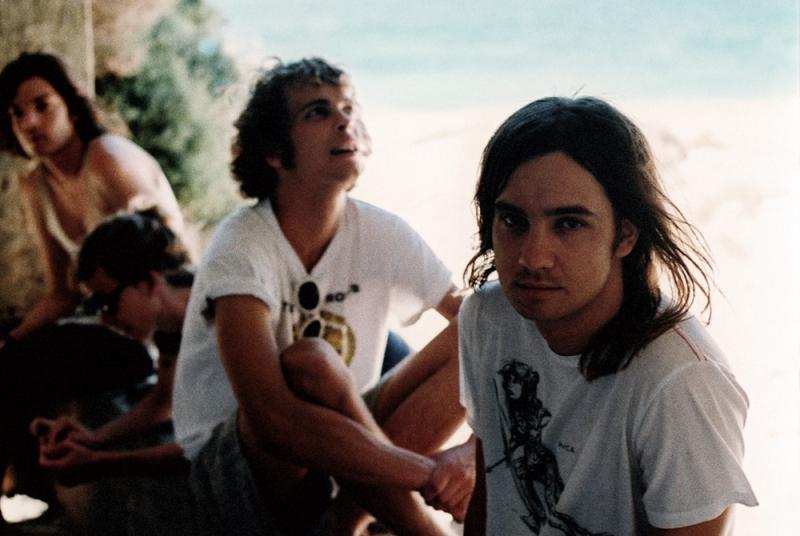Reissue CDs Weekly: Tame Impala - InnerSpeaker (2010➝2020) | reviews, news & interviews
Reissue CDs Weekly: Tame Impala - InnerSpeaker (2010➝2020)
Reissue CDs Weekly: Tame Impala - InnerSpeaker (2010➝2020)
Box-set makeover of one of the last decade or so’s greatest albums

Heard now, InnerSpeaker sounds as it did when it was issued in 2010. Tame Impala’s debut album was crisp, fizzing; a pithy collection of psychedelic rock nuggets which made its case instantly. This was modern psychedelia, infused with a dash of Sweden’s Dungen, which still sounds fresh. Despite brushing the borders of freak-out territory, it was direct. Tuneful too. Fantastic.
Up to this point, the Perth-based Kevin Parker had used the name Tame Impala to release an EP and single, the second of which was recorded in 2009 at London’s prime garage rock set-up, Toe Rag Studios. Travelling there, as The White Stripes had, suggested Parker saw Tame Impala as for more than Australia, his home country. The pre-album records did well there, and InnerSpeaker did even better. A best-seller, it was garlanded with awards. Still, though, psych-rock was a niche genre. In time, there would be nothing niche about Tame Impala. The breakout became akin to that of The White Stripes.
 InnerSpeaker (2010➝2020) has arrived. Despite hitting shops in 2021, it’s marketed as the “10th Anniversary Boxset”. What’s changed since 2010 is the context. Tame Impala are now huge on a world-wide basis. February 2020’s The Slow Rush, their last and fourth studio album, was Top Five in the US and the UK, and similarly successful across loads of other territories.
InnerSpeaker (2010➝2020) has arrived. Despite hitting shops in 2021, it’s marketed as the “10th Anniversary Boxset”. What’s changed since 2010 is the context. Tame Impala are now huge on a world-wide basis. February 2020’s The Slow Rush, their last and fourth studio album, was Top Five in the US and the UK, and similarly successful across loads of other territories.
A four-album set with a slipcase, InnerSpeaker (2010➝2020) packages each record in a 12-inch single style sleeve. There is also a nicely designed, image-dominated booklet including the lyrics, work-in-progress artwork and hand-written notes by Parker from the period – an album track had the working title of “Gary/Gazza Numan” (possibly “I Don't Really Mind”).
In the brief note he’s contributed to the new package’s book, Parker says nothing about where he felt his music sat around 2010, whether he sensed it could connect with listeners or if there were inklings of Tame Impala’s subsequent trajectory. However, he does say “I was going through some video footage that was shot at the time and place I was recording the album with Dom [Simper – bass guitarist and multi-instrumentalist]. Watching back, it really struck me how shy and awkward I was back then. I’m watching my 10 years’ younger self trying to have a conversation thinking ‘Come on man! Stop staring at your feet and twiddling your hands!’ Which is funny because listening back to the demos [included in this release] I get the opposite impression. I hear someone who is wide-eyed and ambitious, and confident…the contrast between my musical self and my social self back then is stark.” A track-by-track commentary would have been useful, as would text on the recording of the album and what came next.
 The first two albums in the set are as per the original release, with slightly less compressed sound than a first pressing. Album Three has the instrumental backing tracks of “Runway, Houses, City, Clouds” and “Expectations” on one side, and new remixes (foregrounding the chunkier elements of the instrumentation) of “Alter Ego” and “Runway, Houses, City, Clouds” on the other. No raison d'être is given for these remixes. The fourth album couples the single track “Demos” with what's titled “Wave House Live Jam” on its flip (the album was mostly recorded at a specially set up Western Australia facility – named Wave House as it overlooked the ocean, pictured left). This final album contains the only music on InnerSpeaker (2010➝2020) which seeks to say something new.
The first two albums in the set are as per the original release, with slightly less compressed sound than a first pressing. Album Three has the instrumental backing tracks of “Runway, Houses, City, Clouds” and “Expectations” on one side, and new remixes (foregrounding the chunkier elements of the instrumentation) of “Alter Ego” and “Runway, Houses, City, Clouds” on the other. No raison d'être is given for these remixes. The fourth album couples the single track “Demos” with what's titled “Wave House Live Jam” on its flip (the album was mostly recorded at a specially set up Western Australia facility – named Wave House as it overlooked the ocean, pictured left). This final album contains the only music on InnerSpeaker (2010➝2020) which seeks to say something new.
“Demos” is 20-minutes, 37-seconds long. It collects song fragments and workouts, sequencing them into a form of cut-and-paste mega-mix. Listening is like experiencing a dial scanning across multiple radio stations, each playing formative versions of bits of InnerSpeaker. “Wave House Live Jam” is an instrumental featuring Parker on guitar, Simper on bass and photographer Matthew Saville on drums. Recorded in July 2009, it’s initially formless with stabs of guitar and the odd arpeggio played over repetitive bass and drum patterns. At 05.19, it begins coalescing into something more interesting with an energised dynamic and, then, just over a minute later the pace picks up. It’s only at around the 13-minute mark that it fully takes off for a minute or so. Album Four is probably for committed completists only.
Overall, InnerSpeaker (2010➝2020) feels shy of getting to grips with why this album is what it is, and why it hit so hard with buyers. A sense of it as integral to an onward path is lacking. InnerSpeaker is one of the last decade or so’s greatest albums and, however smart this package and welcome it as a reminder of the album's merit, Tame Impala’s outstanding debut album has not been given the context it deserves.
- Next week: Wes Montgomery - The NDR Hamburg Studio Recordings
- More reissue reviews on theartsdesk
- Kieron Tyler’s website
Share this article
The future of Arts Journalism
You can stop theartsdesk.com closing!
We urgently need financing to survive. Our fundraising drive has thus far raised £49,000 but we need to reach £100,000 or we will be forced to close. Please contribute here: https://gofund.me/c3f6033d
And if you can forward this information to anyone who might assist, we’d be grateful.

Subscribe to theartsdesk.com
Thank you for continuing to read our work on theartsdesk.com. For unlimited access to every article in its entirety, including our archive of more than 15,000 pieces, we're asking for £5 per month or £40 per year. We feel it's a very good deal, and hope you do too.
To take a subscription now simply click here.
And if you're looking for that extra gift for a friend or family member, why not treat them to a theartsdesk.com gift subscription?
more New music
 Music Reissues Weekly: Robyn - Robyn 20th-Anniversary Edition
Landmark Swedish pop album hits shops one more time
Music Reissues Weekly: Robyn - Robyn 20th-Anniversary Edition
Landmark Swedish pop album hits shops one more time
 Album: Twenty One Pilots - Breach
Ohio mainstream superstar duo wrap up their ten year narrative with in earnest and worthwhile fashion
Album: Twenty One Pilots - Breach
Ohio mainstream superstar duo wrap up their ten year narrative with in earnest and worthwhile fashion
 Album: Ed Sheeran - Play
A mound of ear displeasure to add to the global superstar's already gigantic stockpile
Album: Ed Sheeran - Play
A mound of ear displeasure to add to the global superstar's already gigantic stockpile
 Album: Motion City Soundtrack - The Same Old Wasted Wonderful World
A solid return for the emo veterans
Album: Motion City Soundtrack - The Same Old Wasted Wonderful World
A solid return for the emo veterans
 Album: Baxter Dury - Allbarone
The don diversifies into disco
Album: Baxter Dury - Allbarone
The don diversifies into disco
 Album: Yasmine Hamdan - I Remember I Forget بنسى وبتذكر
Paris-based Lebanese electronica stylist reacts to current-day world affairs
Album: Yasmine Hamdan - I Remember I Forget بنسى وبتذكر
Paris-based Lebanese electronica stylist reacts to current-day world affairs
 theartsdesk on Vinyl 92: Marianne Faithful, Crayola Lectern, UK Subs, Black Lips, Stax, Dennis Bovell and more
The biggest, best record reviews in the known universe
theartsdesk on Vinyl 92: Marianne Faithful, Crayola Lectern, UK Subs, Black Lips, Stax, Dennis Bovell and more
The biggest, best record reviews in the known universe
 Blondshell, Queen Margaret Union, Glasgow review - woozy rock with an air of nonchalance
The singer's set dripped with cool, if not always individuality
Blondshell, Queen Margaret Union, Glasgow review - woozy rock with an air of nonchalance
The singer's set dripped with cool, if not always individuality
 Music Reissues Weekly: Chiswick Records 1975-1982 - Seven Years at 45 RPM
Triple-album 50th-anniversary celebration of the mould-breaking British independent label
Music Reissues Weekly: Chiswick Records 1975-1982 - Seven Years at 45 RPM
Triple-album 50th-anniversary celebration of the mould-breaking British independent label
 Album: Josh Ritter - I Believe in You, My Honeydew
The alt-country singer's latest isn't consistent but does hit highs
Album: Josh Ritter - I Believe in You, My Honeydew
The alt-country singer's latest isn't consistent but does hit highs
 Album: David Byrne - Who is the Sky?
Born to be weird
Album: David Byrne - Who is the Sky?
Born to be weird

Add comment